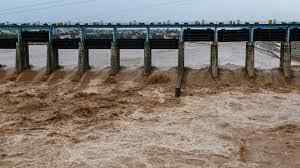Pakistan is facing one of its worst flood emergencies in years, and officials say India’s abrupt suspension of the Indus Waters Treaty (IWT) has made a bad situation far worse. A lack of timely data sharing on dam releases and river levels is leaving Pakistan vulnerable, with floodwaters already wreaking havoc across Punjab and threatening to escalate into a full-blown humanitarian disaster.
Treaty on Hold, Communication Collapses
The IWT, signed in 1960 under World Bank mediation, has for decades governed water-sharing arrangements between the two nuclear-armed neighbors. Its provisions require both countries to coordinate the operation of dams and reservoirs, particularly during floods, to minimize downstream damage.
But in April 2025, India unilaterally announced it would “hold the treaty in abeyance,” effectively halting formal communication channels and the exchange of critical hydrological data. Since then, Pakistani officials say they have been left “flying blind,” relying on delayed or incomplete information about Indian dam releases.
Warning Delays Put Punjab at Risk
The situation turned critical this week when India issued a late alert about potential flooding in the Chenab River’s Tawi tributary, while failing to provide updated figures on the Sutlej River. By the time Pakistan received the Tawi warning on August 24, the Sutlej had already crossed dangerous thresholds, surging past 122,000 cusecs and leaving large parts of South Punjab with little time to prepare.
Officials accuse India of selectively sharing data and not disclosing real-time dam operations, a departure from decades-old practice. Without reliable information, Pakistani authorities are struggling to plan evacuations, safeguard crops, and manage reservoir storage.
Dams, Water Shortages, and Sudden Releases
India’s suspension of the treaty has also triggered unpredictable water flows. Soon after halting data sharing in April, India drastically reduced Chenab outflows, causing irrigation shortages in Pakistan at a time of high agricultural demand. Now, the sudden release of water from upstream dams—without prior coordination—has compounded the flood risk.
In response, Pakistan was forced to release emergency water from its Mangla Dam to compensate for Chenab shortages earlier in the year, a move that has now limited its own ability to manage the ongoing deluge.
Rivers Swelling Beyond Capacity
According to Pakistan’s Flood Forecasting Division (FFD), flood levels across key rivers have reached alarming levels:
- Chenab River: At Qadirabad, outflows exceeded 1,077,000 cusecs on August 27, with all monitoring sites reporting “extremely high flood” status.
- Sutlej River: Exceptional flooding at Ganda Singh Wala is overwhelming embankments.
- Ravi River: High flood conditions persist at Shahdara.
Downstream barrages, including Chashma and Taunsa, are also managing heavy inflows of over 300,000 cusecs each. While the Indus at Tarbela and Jhelum at Mangla remain stable, eastern rivers originating in India are under severe pressure, making coordinated management essential.
Agriculture and Economy Under Threat
Pakistan’s agricultural heartland is bearing the brunt of the disaster, with floodwaters threatening standing crops just weeks before harvest. Agriculture contributes nearly 20% of Pakistan’s GDP and employs a large share of its population; further losses could deepen food insecurity and fuel political unrest.
Experts warn that with monsoon rains ongoing and communication between India and Pakistan effectively severed, the risk of cascading crises is rising. “Without timely data, water management becomes guesswork,” one official told reporters. “That’s unacceptable in a region this dependent on rivers.”
A Diplomatic and Environmental Flashpoint
The suspension of the IWT marks a dangerous turning point in South Asia’s already tense relations. The treaty, often hailed as one of the world’s most successful water-sharing agreements, has survived wars and diplomatic standoffs for over six decades. Its breakdown underscores how geopolitical tensions are increasingly intersecting with climate-driven disasters.
For Pakistan, the stakes are existential: With monsoon patterns growing more erratic and upstream releases harder to predict, the country’s water security—and by extension, food security—remains in jeopardy.
